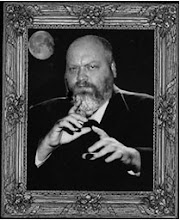I have always had a fascination with the figure of Mary Magdalene. She, of all the characters in the four gospels, spoke to me for some reason. Maybe it was because as a child I was told that she was a repentant whore? She never came off that way to me and I always wondered how the ministers of my upbringing were making this connection? Did they have a "teachers version" of the Bible? You know, the one with the answers in it.
No.
They were just perpetuating the lie.
For your edification, here are some interesting quotes concerning the Magdalena:
"Mary Magdalene was the redeemed sinner who was the first to see Christ after his Resurrection. Through her redemption from sin and her unique knowledge of the Risen Christ, she was regarded by the occult initiates of the Middle Ages as a medium of secret revelation. Those initiates had chosen the planet Venus as her symbol in the cosmos."
- Henry Lincoln, The Holy Place
"...Long ago her name was ISIS, Queen of the benevolent springs, COME TO ME ALL YOU WHO LABOUR AND ARE HEAVY LADEN AND I WILL GIVE YOU REST. Others knew her as MAGDALENE with the celebrated vase full of healing balm. The initiated know her to be NOTRE DAME DES CROSS."
- Le Serpent Rouge
"Mary Magdalene had her surname of Magdala, a castle, and was born of right noble lineage and parents, which were descended of the lineage of kings. And her father was named Cyrus, and her mother Eucharis. She with her brother Lazarus, and her sister Martha, possessed the castle of Magdalo, which is two miles from Nazareth, and Bethany, the castle which is nigh to Jerusalem, and also a great part of Jerusalem, which, all these things they departed among them."
- Legenda Aurea (published in Genoa in 1275)
"In fact, she was also high priestess of the Temple of Ishtar at Magdala, and as such she would have been the keeper of the doves. Furthermore, she was a Benjamite, the tribe which was ostracized because they were of the line of Cain. So too was Hiram Abiff, architect of the Temple of Solomon."
- David Wood, Genisis
"In popular Christian tradition she [Mary Magdalene] is a prostitute who finds redemption by apprenticing herself to Jesus. And she figures most noticeably in the Fourth Gospel, where she is the first person to behold Jesus after the Resurrection. In consequence she is extolled as a saint, especially in France - where, according to medieval legends, she is said to have brought the Holy Grail."
- Baigent, Leigh & Lincoln, The Holy Blood and the Holy Grail
"The idea that Mary [Jesus' mother] had been an adultress never completely disappeared in Christian mythology. Instead, the character of Mary was split into two: Mary the mother of Jesus, believed to be a virgin, and Mary Magdalene, believed to be a woman of ill repute. The idea that the character of Mary Magdalene is also derived from Miriam the mythical mother of Yeishu, is corroborated by the fact that the strange name 'Magdalene' clearly resembles the Aramaic term mgadla nshaya meaning 'womens' hairdresser'....There was a belief that Yeishu's mother was 'Miriam the women's hairdresser'. Because the Christians did not know what the name 'Magdalene' meant, they later conjectured that it meant that she had come from a place called Magdala on the west of Lake Kinneret. The idea of the two Marys fitted in well with the pagan way of thinking. The image of Jesus being followed by the two Marys is strongly reminiscent of Dionysus being followed by Demeter and Persephone."
- Hayyim ben Yehoshua, "Refuting Missionaries, Part 1: The Myth of the Historical Jesus"
"...The Magdalene is not, at any point in any of the Gospels, said to be a prostitute. When she is first mentioned in the Gospel of Luke, she is described as a woman 'out of whom went seven devils'. It is generally assumed that this phrase refers to a species of exorcism on Jesus's part, implying the Magdalene was 'possessed'. But the phrase may equally refer to some sort of conversion and/or ritual initiation. The cult of Ishtar or Astarte - the Mother Goddess and 'Queen of Heaven' - involved, or example, a seven-stage initiation [the seven veils]. Prior to her affiliation with Jesus, the Magdalene may well have been associated with such a cult. Migdal, or Magdala, was the 'Village of Doves', and there is some evidence that sacrificial doves were in fact bred there. And the dove was the sacred symbol of Astarte."
- Baigent, Leigh & Lincoln, The Holy Blood and the Holy Grail
"As for the Wisdom who is called 'the barren,' she is the mother of the angels. And the companion of the Savior is Mary Magdalene. But Christ loved her more than all the disciples and used to kiss her often on her mouth. The rest of the disciples were offended by it and expressed disapproval. They said to him, 'Why do you love her more than all of us?' The Savior answered and said to them, 'Why do I not love you like her?"
- Gospel of Philip
"...The [Gnostic] Gospel of Mary depicts Mary Magdalene (never recognized as an apostle by the orthodox) as the one favored with visions and insight that far surpass Peter's. The Dialogue of the Savior praises her not only as a visionary, but as the apostle who excels all the rest. She is the 'woman who knew the All'."- Elaine Pagels, The Gnostic Gospels

